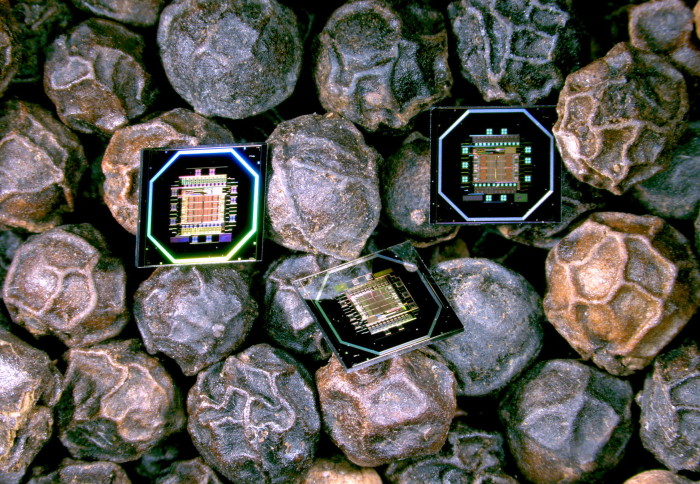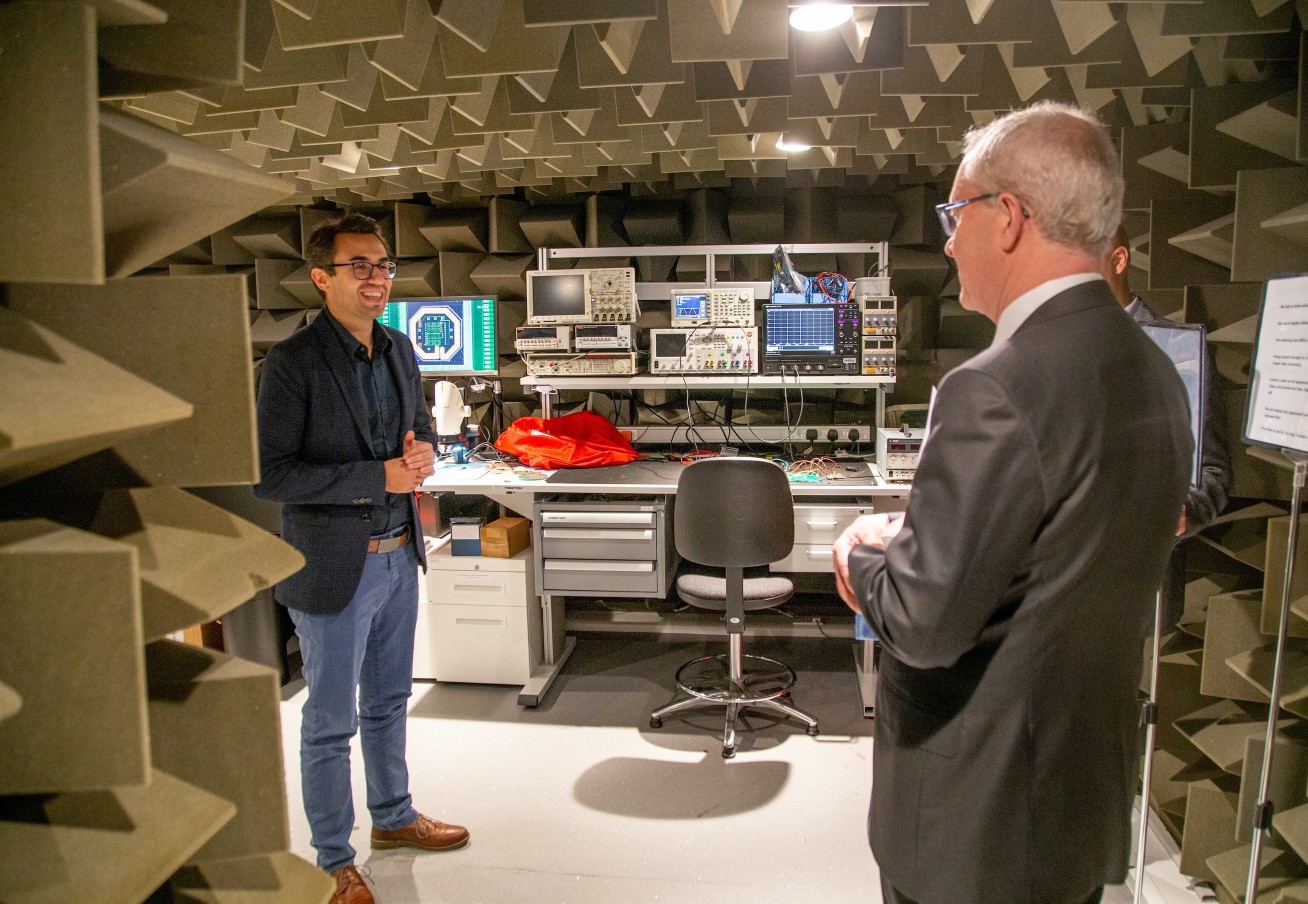MintNeuro: redefining neurological interventions with bioelectronic implants
by Gavin Reed

MintNeuro's ultra-low power, wireless bioelectronic implants are about the size of a peppercorn - 100 times smaller than current devices
A new generation of bioelectronic implants created by Imperial spinout MintNeuro could transform treatment of neurological conditions.
The devices build on over a decade of research and are being developed by MintNeuro, a new Imperial spinout.
A team of Imperial engineers with extensive experience in ultra-low power implantable bioelectronics have joined forces with external experts in neuroscience and medical device translation to launch MintNeuro.
The company will develop and commercialise a platform technology for tiny implantable devices to treat neurological conditions in a less invasive, yet more precise way. MintNeuro has licensed its core technology from Imperial College London, and will develop novel implantable devices that are about the size of a peppercorn – over 100 times smaller than current state-of-the-art devices.
The spinout was co-founded by Professor Tim Constandinou, Dr Dorian Haci, Professor Andrew Jackson (Newcastle University) and Professor Tim Denison (University of Oxford), and an expert technical team (Dr Ian Williams, Dr Katarzyna Szostak-Lipowicz, Dr Adrien Rapeaux, Dr Peilong Feng, Mr Matthew Cavuto).

Bioelectronic implants are devices placed within the body that interact with the brain and nervous system. They can sense and/or modify electrical activity originating from neurons – electrically-excitable cells that communicate with other cells through large (biological) neural networks.
Such implants have been in clinical use for decades, for example, to restore hearing in deaf people (cochlear implants) or to treat tremors in Parkinson’s disease (deep brain stimulators). Advances in low-power electronics, integrated circuit and microsystem technologies have created the potential to develop smaller, less invasive implants that are completely wireless, allowing several to be used in a distributed way. This opens up new opportunities for bioelectronic interventions.
“Neurological conditions are a major and growing issue in society, responsible for as many as one in four disabilities and one in six deaths,” says Professor Constandinou, MintNeuro’s Chief Technology Officer. “Pharmaceutical treatments can be effective – but what we can treat is limited and new medicines for neurological conditions are extremely hard to develop, so we should explore alternative and complementary approaches.”
Implantable bioelectronics represent one such approach. Devices can precisely target specific regions in the brain or nervous system, to sense and/or modulate the electrical activity, offering tantalising possibilities. Implanted bioelectronics can provide near-instantaneous results, with fewer side effects, and can be turned off or removed if the cessation of effect is desired.
Because of the high device cost and lengthy, extensive surgery required, implantable devices are currently considered 'last resort' for neurological interventions. MintNeuro wants to change that." Tim Constandinou Professor of Bioelectronics, Imperial College London
Professor Constandinou explains: “Implantable device technology hasn’t fundamentally changed in decades. There is a circuit board, a battery or large coil for receiving power, all of which is housed in a bulky metal casing – about the size of a matchbox. A cable connects this to the electrodes – positioned in the desired brain region. The cable can be half a metre or more in length and is tunnelled under the skin. Because of the high device cost and lengthy, extensive surgery required, implantable devices are currently considered ‘last resort’. MintNeuro wants to change that.”
The company’s implant technology is based on expertise in microelectronics gained through over ten years of UKRI-funded research. This has led to the creation of tiny chips that can communicate wirelessly and are a designed to remain safely in the brain for decades. The small payload and reduced need for future intervention mean that they could be implanted through minimally-invasive surgical techniques.
MintNeuro is focussed initially on validating and applying its implant technology for sensing applications such as epilepsy neuromonitoring or brain computer interfaces and has in place a clear pipeline to further develop the technology for neuromodulation in the future.
Dr Dorian Haci, Chief Executive Officer, has been with the team for eight years, initially as a student, then postdoctoral researcher in neural implants, and most recently as a Royal Academy of Engineering Enterprise Fellow.
Describing the company’s vision, he says: “MintNeuro is dedicated to delivering a range of miniature neural implants for specific neurological interventions. These will significantly reduce invasiveness compared to today’s implantable devices and enable widespread adoption, so what was once considered last resort will progressively become elective at earlier stages in disease treatment.”
First-in-human validation
MintNeuro’s first target application is for patients suffering from drug-resistant epilepsy (where seizures are not controllable through medication). Around 200,000 people in the UK suffer from this debilitating disease, and for them, surgery is the main remaining option to achieve seizure-freedom.
However, to identify eligibility for surgery and surgical targets, it may be necessary to perform invasive brain activity recordings by inserting electrodes deep into the brain. Currently, the patients must remain largely bedbound in hospital for up to three weeks with electrode wires running through the skull and skin while these recordings take place. Replacing the bulky equipment with a miniature implantable wireless sensing device would enable patients to return home following a minimally-invasive procedure.
Professor Constandinou says that MintNeuro has plans to validate its technology in a non-implantable first-in-human trial in collaboration with an NHS Trust. “Epilepsy pre-surgical brain recordings provide us a unique opportunity to demonstrate our technology in a safe way. This will allow us to develop our product to significantly improve the patient experience."
Funding and support
Research underpinning MintNeuro was funded by EPSRC and Wellcome Trust. Additional translational support was funded by EPSRC through an Impact Acceleration Account. Members of the team benefitted from a range of support, including a RAEng Enterprise Fellowship and participation in MedTech Superconnector.
Article supporters
Article text (excluding photos or graphics) © Imperial College London.
Photos and graphics subject to third party copyright used with permission or © Imperial College London.
Reporter
Gavin Reed
Enterprise